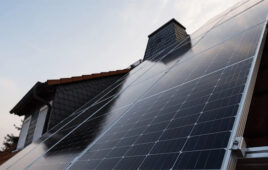
By Lisa Cohn, Aurora Solar
A solar panel spec sheet provides valuable information about the operating parameters of a panel and can help designers, engineers, and installers determine how to configure a solar PV system.
The panel spec sheet will tell you about the panel’s electrical power production, including its efficiency and how it operates with changing temperatures, as well as mechanical information like the dimensions and wind loads. This information is required to get an accurate performance simulation.





There’s usually the STC rating which ‘assumes’ perfect conditions of solar insolation of 1,000 watts per square meter of solar PV panel space at around 25 degrees C. The PTC has the actual panel rating per degree C above or below 25 degrees C. Often NOCT will take into account a ‘range’ of panel outputs for temperature, light and ‘heat removal’ of the solar PV panels. NOCT is useful with regions in the more northern climates with shorter sun hours a day on average. Many still use the ‘salesmen’s pitch’ of STC when quoting solar PV installation costs, but depending on regional light availability on average per year and temperature fluctuations one should be using perhaps PTC for a better design criteria over the entire year’s possible solar PV harvest. As costs still seem to be coming down for smart ESS storage systems, over building the system to include energy storage and resiliency is becoming the new Solar plus storage system to adopt.
I think safety is a key here for using STC than just a salesman giving a wrong pitch. And actually NMOT should be used than NOCT since NOCT is open cell temperature performance whereas NMOT is under load. Whole cost structure is also set on STC ratings. I think the burden is on module manufacturers to make panels more powerful which they will. I agree that we are possibly looking at energy independence. Decentralization of energy is happening and will keep happening at even faster rates.